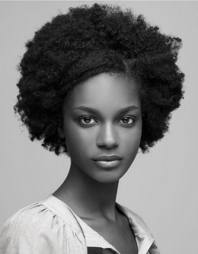Our hair is
an extension of our body and therefore should be treated with equal amount of
care. I decided to make an effort to predominantly use products with natural ingredients
that would nurture my hair and not be harmful to my body. This simple decision lead me to realise that
ready made hair products which I relied on for years contain too many chemicals
or ingredients that hinder healthy hair growth. I was pleased to find out that
I can easily make my own hair products with 100% natural ingredients and tailor
them to suit my hair’s specific needs. At present my staple natural ingredients
are:
Shea Butter (Butyrospermum parkii)
African
Shea butter has been used for centuries for its unsurpassed ability to protect
and regenerate the skin. It comes from the nut of the Karite tree, which grows in
specific areas of West
Africa. The Karite three can grow up to 20 meters
high, and its trunk can reach up to 1 meter in diameter. It produces its first
fruit when it is about 25 years old, and reaches full production at the age of
40-50, and can live up to 300 years. The fruits of the Karite tree resemble
large plums, approximately 3-6 cm. The Karite nut is edible and contains 1-3
seeds surrounded by a thin brittle hull. The creamy substance, known as Shea
butter, is produced from these seeds.
Used in
its natural form, 100% unrefined Shea butter softens, protects and makes the
hair more pliable. Shea butter
provides moisture to dry and damaged hair from the roots to the tips, leaving
it healthy and shiny. Because it's rich in vitamins A and E, Shea butter
soothes dryness, repairs breakage, and mends split ends.
In
order to make the most out of Shea butter it is best to use 100% unrefined Shea
butter as the refining process removes most of its healing properties. Unrefined
Shea butter is either cream or yellow in colour (as opposed to the white
refined product).

Jojoba
Oil (Simmondsia chinensis)
Jojoba oil is a liquid wax derived from the seeds of small
Jojoba tree. A shrub native to southern
Arizona, southern California, and north-western Mexico. The oil makes up approximately 50% of the Jojoba seed by
weight. This odourless liquid is virtually identical to sebum, the oil our scalp
naturally produces, and can easily be absorbed by hair and scalp. Jojoba oil
lubricates the hair shafts. It is an effective natural cleanser that helps rid
the scalp of excessive sebum build-up.This
oil provides healing benefits to the hair and scalp.
These qualities makes Jojoba oil ideal for use with extensions or natural hair styles that are kept for longer periods of time.
Jojoba oil acts as a hair sealant by forming a thin coating on the hair
shaft. It smooths and seals the hair cuticle, even providing protection from
any damaged caused by combing and brushing the hair. Jojoba oil helps lock
moisture into the hair, thus protecting it from ultraviolet rays from the sun.
As a result the hair is fortified, making it stronger and resulting in less
breakage.
Coconut Oil
Coconut oil
is one of the best oils one can use on natural hair. It softens, detangles and
it is a great hair conditioner. Another benefit of this oil is its ability to
strengthen the structure of damaged, devitalised hair. It is often used as a
pre wash conditioner. I use this oil a great deal and love its smell. It brings
back memories of my grandmother who used it on my hair when I was a child.
My Shea
butter hair recipe:
I mix the
three ingredients described above to use as an everyday hair cream. This is the main product I use on my hair. I
have been using it since I've gone natural and it works wonders on my super dry
hair! It is a strait forward mix to make and once made it lasts me for about three months. So here’s the recipe:
v 80g of Shea butter (100% unrefined)
v 4tablespoons of Jojoba oil
v
4 tablespoons of Coconut oil
v
5
drops of essential Lavender oil
1. Melt the butter and Coconut oil in a
mixing bowl using the Bain Marie method.
2. Once melted add the Jojoba oil. Place the bowl in the freezer for a few minutes to chill. Wait for the oils to start to partially solidify (do not allow it to become frozen solid otherwise it will not blend well).
3. Then I use an electric hand mixer
to whip the ingredients together until the butter turns into a soft and creamy
consistency. This should take between five and eight minutes.
4. When the Shea
butter turns creamy (something akin to whipped cream consistency) add the Lavender essential oil and mix for another minute
or so.
5. I then place my whipped Shea mix into a small clip-top Kilner jar. That's it, my Shea butter mix is ready to use.
Tip
If you do not have a mixer you can simply melt the butter using the Bain Marie method. Then add the oils of your choice. Pour the content into your chosen container. Allow it to cool and and solidify. The Shea butter mix will then be ready to use. Although it will not feel as luxurious as the whipped version it works equally well.
In relation to quantities the right mix should be about 75% solid butter to 25% liquid oil.
I get my Shea
butter from Enaissance on line store - http://www.enaissance.co.UK.
This company supplies a wide variety of natural ingredients at good prices. You may also
be able to find a wide range of natural oils and ingredients including the
above at your local health food stores such as Holland and Barrets or equivalent.
Do you have a favourite hair butter recipe to share with me?
Marisa.
























.jpg)